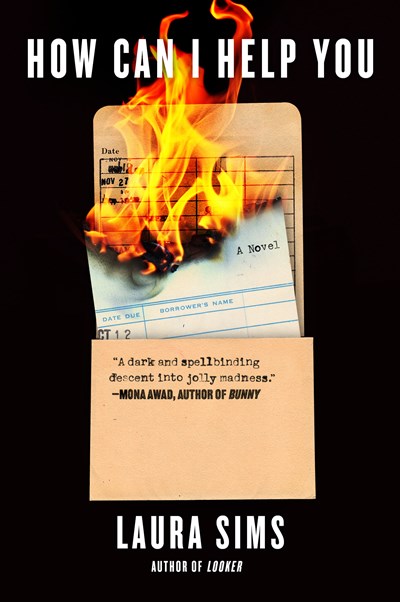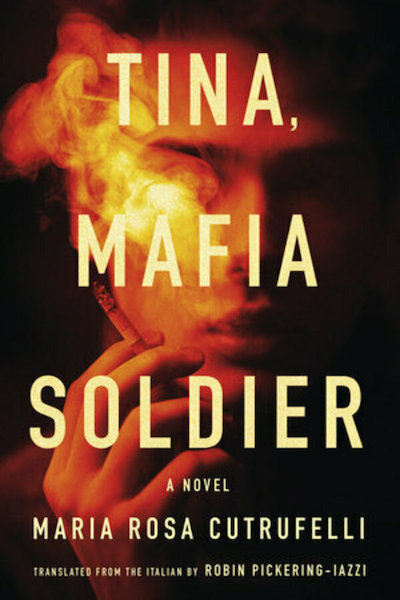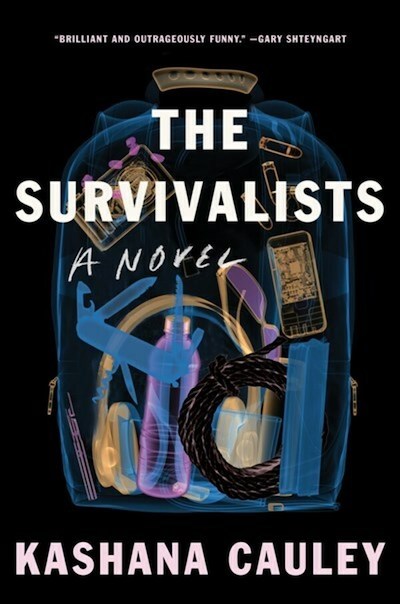Clear your calendar, silence your phone, and settle down to enjoy Laura Sims’ latest book in one joyous sitting. You deserve it and I guarantee you’ll thank me. Set among library workers in a small public library—no author has ever gotten library culture as right as Sims—this book is as unsettling as a Shirley Jackson novel with the same crazy stalker energy of a Patricia Highsmith tale. It’s time to move on for ex-nurse Margo, who leaves in her wake scores of suspicious deaths in a handful of hospitals. A library clerk position at the Carlyle Public Library gives her a chance at redemption, along with a new name, hair color, and wardrobe. And she can still help people, “not the way I helped them before, at the hospital, but still.” She’s able to keep the lid on her urges, for the most part, until two years later when Patricia, a new reference librarian, is hired. The two strike up a friendship of sorts—they live in the same apartment building—but when an elderly patron dies in the bathroom, and Margo becomes way over-excited, Patricia finds herself becoming obsessed with Margo and begins documenting her actions. The narrative alternates between the two women as the novel grows deeper, darker, and creepier, ending in a stunning, perfect climax.
Star
This book is centered on one question: back in 1995, did Omar Evans, then a twenty-five-year-old Black man and athletic trainer, murder high school student Thalia Keith? And it’s narrated by one woman, podcaster and Thalia’s roommate, Bodie Kane. From there this novel extends in myriad directions, covers over twenty years, takes us across the country, and dives into Bodie’s past and present, as well as the questionable memories of a whole cast of characters. Yes, it’s a lot, but it’s also brilliantly successful and absolutely riveting. In 2018, Bodie was invited back to teach for two weeks at The Granby School, the elite New England boarding school she attended over 20 years ago. Her students are creating podcasts, with one choosing to revisit Thalia’s murder, a topic Bodie has kept at arm’s length. But gradually Bodie wonders if the police arrested the wrong man and the murderer is walking free. Ultimately convinced of Omar’s innocence, she reaches out to classmates for memories, photographs, any records that could help piece together that evening over twenty years ago. In many ways, what Bodie does is reopen a cold case, without any help from the cops, one that’s rich in newly found details, tacitly informed by #MeToo and Black Lives Matter. While addressing much of the book to a suspect we never meet, over the next several years, Bodie and her students raise enough questions to be taken seriously. Overlaying all this is Bodie’s personal life, including trauma from her past and a break-up with her husband, an artist accused of sexual harassment. Add to this the murders of other women that Makkai tucks around the main narrative, giving Thalia’s murder ever greater context. This is one of the books I’m most eager to share with a book group. It demands discussion.
My first impression of this 1994 Italian novel was that the translator must have gotten quite a workout, with, for example, a character described as exhibiting “childish mischievousness…elusive, playful provocation” and the setting called “contaminated, ruined, corrupted, infested, dirty.” Next came the confusion over the story’s era. It takes time to grasp that we’re visiting the 1980s in Sicily, which is one part of what makes the book so rich; the island is an anachronism. The Sicilian words sprinkled throughout also seem fermented relics of a bygone time; words like scassapagghiara, thugs, and spasciamarroni, guttermouth. Growing from this arid dystopia is a masculidda, or tomboy, called Tina (she creates this nickname for Cettina because it’s “short, hard, a bit foreign”). Time is again confused here, with Tina acting both much older than her teenage years, such as when she takes over a band of boy mafia trainees, and much younger, in her obsession with impressing grownups so that she can become “respected,” i.e., a mafia member. The narrator, who’s writing a book about Tina, leads us to the Bronx, as Tina’s run-down neighborhood is called by locals. Our protagonist is strangely absent from the town and readers aren’t sure until the end if she’s on the run, in prison, or maybe dead. Through the book we get a look at the notorious, shocking life of the girl who defied her father’s saying that “A night [is] wasted when you make a girl” to satisfy violent ambitions. Well worth the read, especially for those who enjoy stories of women smashing barriers.
A classic police procedural that does a miraculous job of balancing the investigation on the one hand and the complex personal lives of the detectives on the other. One of Helsinki’s most successful business leaders is murdered in his home, by a kitchen knife to his heart. He was on his way to a dinner celebrating his company’s fiftieth anniversary, an event overshadowed by protests because of recent layoffs he’s authorized. Yusuf, one of the leading detectives throughout this series, is put in charge of the investigation, which leads inward, with a meticulous examination of the apartment, and outward, contacting many of the executive’s colleagues and just individuals with whom he may have had contact. Unnerved at his leadership position, Yusuf brings on Detective Jessica Niemi, his partner in the earlier books, who’s now on leave trying to escape from her personal demons—literally, not metaphorically. As the story briskly unfolds—Seeck keeps the plot moving—the past and the present collide in a terrifying way. While this can be a stand-alone, it’s best to read it as part of a series. For fans of Camilla Läckberg and Jo Nesbø.
Ready for something completely different? This brilliantly odd and unexpected tale sees striving corporate lawyer Aretha go on—finally!—a great date, one that doesn’t end with her crawling out the bar’s bathroom window to escape (yes, she has) or wondering mid date if she’s already dead. Aaron does arrive in the bar looking like he “[chops] wood for a living right there in the middle of Brooklyn,” but that’s not so unusual for the area. What is unusual is that he’s part of the “dead parents club.” His mom died of cancer while Aretha’s were gored by deer, but her past dates have made her less choosy. This might be why Aretha tries to chalk it down to individuality when she finds that Aaron and his housemates have built a bunker in their garden to keep safe when the world is destroyed, eat only optimized protein soy bars, and own guns (not just a few). As Aretha drops further into this bizarro world, into crime, and away from Aaron, the sadness underneath the spectacle shows itself: this tale is about the rot that sets in when you sell something that doesn’t belong to you. Plagiarism features, with housemate James a perpetrator and Aretha, in a separate event, a victim, but even worse is Aretha and Aaron selling versions of themselves that can never be. A must-read debut.
I love mysteries that feature the famous, from Walt Whitman to Dorothy Parker to Eleanor Roosevelt. But featuring a living celebrity—in this case, Bernie Sanders—is even more of a challenge, one that Shaffer succeeds at wonderfully. Gen Z intern Crash Robertson is our wisecracking intern and narrator, and after months of answering phones in the DC office—from constituents who don’t know how to text?—she gets to accompany the senator on a fall-recess trip to Vermont. By chance, they head to Eagle Creek, Crash’s hometown, and end up staying in her mother’s B&B. But what has the makings of a low-key visit with constituents, and plenty of apple griddlecakes, suddenly gets upended when Crash finds the body of the local banker floating in Lake Champlain. Crash’s running commentary on Bernie—who’s always ready to deliver a lecture on the declining honeybee population, or the cozy series he’s reading, set in a cannabis bakery in the Northwest—makes for a good part of the humor in the book. But when a second citizen goes missing, it’s time for our team to get down to work. The biggest suspect is a tech-obsessed one-percenter, think Elon Musk, who’s buying up acres of maple trees, driving out local farmers, and monopolizing maple syrup production in a move Bernie dubs “Big Maple.” Unmitigated fun for everyone, no matter where they might fall on the political spectrum. Shaffer is also the author of the Obama mysteries, Hope Never Dies and Hope Rides Again.
The walled-off feeling of loneliness in a crowd pervades the pages of Hlad’s piercing historical thriller. Based on a fascinating and little-known true story of World War II, the tale sees librarians from New York Public Library sent throughout Europe to gather materials published by axis powers, photograph it, and send it via microfilm (the thumb drive of its day) back to New York to aid in overthrowing Hitler. Our hero is Maria Alves, a Portuguese American who, due to her parents’ jobs as newspaper photographers, lived all over the world as a child and speaks six languages. Sent to a neutral—but still dangerous—Portugal to scour bookstores for war-relevant information, her cover is that she is working for the Library of Congress to gather materials that are in danger of being destroyed in the conflict. Under no circumstances is she to engage in spying, but that undertaking soon falls by the wayside as the extent of the horror in nearby occupied France becomes apparent. Also affected by the French occupation is Tiago Soares, a Lisbon bookseller whose Grand-père and Grand-mère in Bordeaux run an operation that smuggles Jews to Lisbon, where increasing crowds of penniless, paperless refugees await passage to the United States. Hlad’s immersive portrayal of wartime Lisbon and its inhabitants, of the loneliness caused by the terror that anybody at any time could be an informant, plus his captivating thriller/romance tale make this a must-read, especially for fans of Kate Quinn’s The Rose Code.
I’ll admit it: it took me several tries to get past this novel’s disturbing opening scene, in which two women violently murder a man they just met and with whom they have zero connections. They stick him in the trunk of their car for a few hours, only to discover he’s not actually dead. Then they meticulously prep the body—who knew removing teeth to minimize identification was a thing?—and heave the now assuredly dead man over the side of a mountain. Turns out, this is just the latest murder of the serial killer sisters, identical 25-year-old triplets. Typically, their thing is to make men want them and fall in love with them. Then they kill them. It’s about a six-month process, and the first two sisters have racked up three murders each. But Sissy, our protagonist, has yet to make her first kill. She’s pulled her weight with her expertise in cleanup, removing any evidence that could connect the sisters to a murder site or a corpse. But she’s overdue in the murder department. The women have arrived in Arizona so that Sissy can focus on herself, and in no time she’s met the handsome, gentlemanly, church-going widower Edison. They quickly bond, and Sissy delights in her love affair with Edison as much as she enjoys imagining how she’ll kill him and where she’ll bury him. Until things change. Her desire to kill ebbs away, and her sisters grow increasingly anxious as they fear Sissy is pulling out of their agreement. A new, terrifying take on serial killers that will give fans the sleepless nights they crave.
Bakers, cozy fans, and those who just love a fun, traditional mystery will want to abandon whatever they’re doing to read this novel to its very bloody end. A mashup of the TV series The Great British Bakeoff and the film Knives Out, the book stars Betsy Martin, “American’s Grandmother,” who’s sweet as pecan pie on the outside but tough as overmixed batter on the inside. Betsy created the show Bake Week, which is filmed at her Grafton, Vermont mansion—no fear of Spotted Dick in New England, TG— which also houses the six well-drawn contestants. For years, Betsy has ruled supreme over the show, but this season she’s being forced by the producers to take on another judge to—shudder—sex things up. What could go wrong? First, someone switches the sugar and salt, then a burner “accidentally” gets set on high. In the end, the whole show comes crashing down like some deflated meringue. But you’ll hear no spoilers from me—getting to the resolution on your own is too much fun.
Elana knows she should have heeded the red flags. When she met her husband, Jackson, it was a whirlwind romance…a little too whirlwind, as they got engaged within weeks. Right before the wedding, he admits that he was married before, twice, and is twice divorced. He also seems to have rigid ideas about what she and her young daughter, Phoebe, can eat, that she should stay home rather than work, and that every penny she spends should come from him and be accounted for. But he also seems head over heels, as is she. Maybe she’s overreacting? Then on their wedding day, one of his ex wives shows up to warn Elana not to go ahead with the ceremony, claiming that Jackson is a controlling, violent monster who took her daughter, who’s still missing, and will take Phoebe, too. That’s the past portion of the story; flash forward to the present and Elana is in a way-too-real version of the life she was warned about, afraid to stay but even more afraid to go, even if she weren’t penniless and surveilled at every moment. While readers drop deeper into the emotional hole dug by Jackson and feel the walls closing ever tighter, they’ll empathize with every uptick in Elana’s fury and despair. And as they begin to wonder whether it’s possible to kill a fictional character themselves, and how slow a death they could make it, the pages fly by, as do the twists, for better and much worse. Don’t start this on a work night, there’s no hope you’ll put it down.










